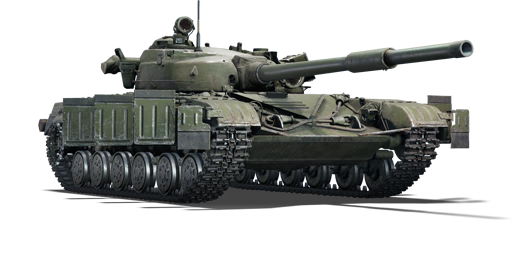



The T-64A is the second variant of the T-64 main battle tank family. Even as the first variant of the T-64 was being produced, the design team was hard at work on a new variant, codenamed Object 434 (designated T-64A), to improve the firepower. The new variant was to be outfitted with a brand new and extremely powerful 125 mm D-81T tank gun from the Perm weapons factory. Given the increased calibre of the main armament, it is estimated that only a maximum of 25 rounds can be carried. This was unacceptable to the Soviet designers, but strict dimensional constraints prevented them from enlarging the design to increase interior space. The solution was to replace the human loader with a mechanical autoloader, reducing the crew to three and introducing autoloaders to Soviet main battle tanks for the first time.
Introduced in Update 1.71 "New E.R.A.", the T-64A should be played primarily defensively, using terrain for cover and pushing objectives with caution. It has good firepower but mediocre armour, average mobility, and a very slow reverse speed. Since many of the vehicles it will face will easily penetrate its hull armour, the T-64A should be played as a sniper, and close-range engagement should be avoided. Since the majority of the vehicles it will encounter have greater mobility, it is critical to be aware of enemies flanking around the battlefield.
| Ammunition | Type | Armor penetration (mm) at a distance: | |||||
|---|---|---|---|---|---|---|---|
| 10 m | 100 m | 500 m | 1000 m | 1500 m | 2000 m | ||
| HEATFS | 440 | 440 | 440 | 440 | 440 | 440 | |
| HE | 35 | 35 | 35 | 35 | 35 | 35 | |
| APFSDS | 320 | 317 | 303 | 285 | 266 | 248 | |
| HE | 42 | 42 | 42 | 42 | 42 | 42 | |
| APFSDS | 440 | 430 | 420 | 410 | 405 | 400 | |
| APFSDS | 425 | 420 | 415 | 405 | 393 | 380 | |
| Belt | Belt filling | Armor penetration (mm) at a distance: | |||||
|---|---|---|---|---|---|---|---|
| 10 m | 100 m | 500 m | 1000 m | 1500 m | 2000 m | ||
| AP-I/API-T | 13 | 12 | 7 | 3 | 2 | 0 | |












Mobility | |
|---|---|
Protection |
|---|
Firepower | ||
|---|---|---|